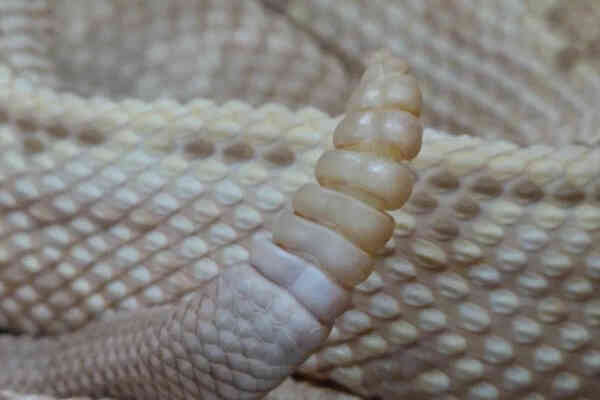Rattlesnakes (Crotalus or Sistrurus) are named for the snap at the end of their tail that makes a rattling sound to warn other animals. There are more than thirty species of rattlesnakes native to America. While most rattlesnakes have healthy populations, some are considered threatened or endangered due to factors such as poaching and destruction of their native habitat.

Scientific name: Crotalus or Sistrurus
Common name: Rattlesnake
Basic Animal Group: Reptiles
Dimensions: 1.5–8.5 feet
Weight: 2-15 lbs
Lifespan: 10-25 years
Diet: Carnivores
Habitat: Habitats are diverse; most common in open rocky areas, but also native to deserts, grasslands, and forests
Conservation status: Most species are classified as Least Concern, but a few species are classified as Endangered
Rattlesnakes are named for the distinctive snapping sound at the tip of their tail. When it vibrates, it creates a buzzing or rattling sound. Most rattlesnakes are light brown or gray, but some species can be bright colors, such as pink or red. Adults are typically 1.5 to 8.5 feet tall, with most being less than 7 feet tall. They weigh from 2 to 15 pounds.

Close-up of a rattlesnake's tail.
The rattlesnake's fangs are connected to the venom tube and have a curved shape. Their canines are continuously produced, meaning they always have new canines growing behind their existing ones so that they can be used as soon as the old ones fall out.
Rattlesnakes have a heat-sensing pit between each eye and nostril. This pit helps them hunt prey. They have a type of "thermal vision" that helps them find prey in dark conditions. Because rattlesnakes have heat-sensitive sunken organs, they are considered rattlesnakes.
Rattlesnakes are found throughout the Americas, from Canada to Argentina. In the United States, they are common in the Southwest. Their habitats are diverse and can live in plains, deserts, and mountains. However, rattlesnakes typically live in rocky environments because rocks help them find cover and food. Since they are reptiles and ectotherms, these areas also help them control temperature; depending on the temperature, they will bask on top of the rocks or cool off in the shade under the rocks. Some species enter a hibernation-like state during the winter.
Rattlesnakes are carnivores. They eat a variety of small prey, such as mice and other small rodents, as well as smaller birds. Rattlesnakes are stealthy hunters. They lie in wait for their prey and then attack it with their fangs, immobilizing it. Once its prey dies, the rattlesnake swallows it head first. Due to the snake's digestive process, rattlesnakes will sometimes look for a place to rest while they digest their food.
In the United States, most rattlesnakes breed between June and August. Males have a sexual organ called a hemipenis at the base of their tail. The hemipenis retracts when not in use. Females have the ability to store sperm for long periods of time, allowing them to reproduce long after the mating season. The gestation period varies among species, with some lasting nearly 6 months. Rattlesnakes are ovoviviparous, meaning the eggs are carried inside the mother's body, but the young are alive.
The number of offspring varies between species, but is usually 5 to 20. Females usually breed only every two to three years. Newborns are born with functioning venom glands and fangs. The cubs do not stay with their mother for very long and will fend for themselves soon after birth.
Most rattlesnake species are classified as "least concern" by the International Union for Conservation of Nature and Natural Resources (IUCN). However, the populations of most rattlesnake species are declining, and a few, such as the Santa Catalina Island rattlesnake (Crotalus catalinensis), are listed as "critically endangered." Predation and human encroachment on habitat are two of the most prevalent threats to rattlesnake populations.
There are more than 30 species of rattlesnakes. Common species include the eastern diamondback rattlesnake, timber rattlesnake, and western diamondback rattlesnake. Wood may be more passive than other species. Eastern diamondback spiders have a unique diamond-shaped pattern that helps them blend into their environment. The Western diamondback is typically the longest of the rattlesnake species.
Thousands of people in the United States are bitten by snakes every year. Although rattlesnakes are usually passive, they will bite if provoked or frightened. Snake bites are rarely fatal if proper medical care is sought. Common symptoms of a snake bite include swelling at the bite site, pain, weakness, and sometimes nausea or excessive sweating. Seek medical attention immediately after being bitten.
animal tags: rattlesnake snake
We created this article in conjunction with AI technology, then made sure it was fact-checked and edited by a Animals Top editor.